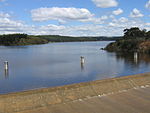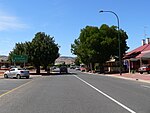Williamstown, South Australia

Williamstown is a small South Australian town on the southern fringe of the Barossa Valley wine-growing region. It is 51 km north east of Adelaide and 16 km south-east of Gawler. Williamstown was originally known as Victoria Creek. The township was laid out in 1858 by Lewis Johnston, or Johnstone, on land he purchased in 1857, and named for his son.Williamstown has an elevation of 310 m and an average rainfall of 680 mm. It has a summer average temperature of 31 °C with temperatures often reaching the mid 40s, and a winter average temperature of 15 °C, with nights dropping below freezing, which makes the region excellent for the cultivation of fruits, especially grapes in the lower riverine alluvial deposits.
Excerpt from the Wikipedia article Williamstown, South Australia (License: CC BY-SA 3.0, Authors, Images).Williamstown, South Australia
George Street, The Barossa Council
Geographical coordinates (GPS) Address Nearby Places Show on map
Geographical coordinates (GPS)
| Latitude | Longitude |
|---|---|
| N -34.67212 ° | E 138.888362 ° |
Address
George Street
George Street
5351 The Barossa Council
South Australia, Australia
Open on Google Maps





